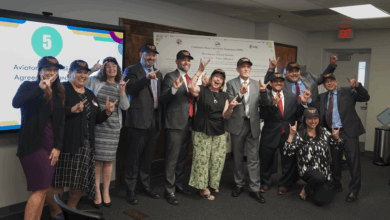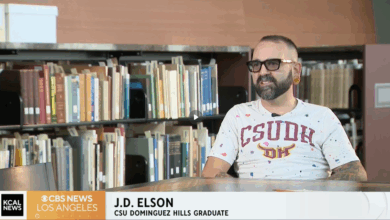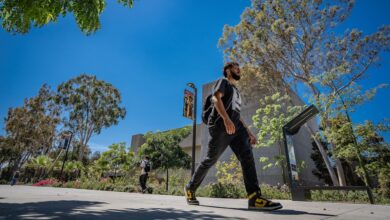 At a public forum on Wednesday, March 23, Associate Professor of Information Systems and Operations Management Jian-Yu (Fisher) Ke and his team will unveil results of the South Bay Economics Institute’s latest study on the current position of California’s freight system compared with other states’, and policy recommendations to increase California’s supply chain competitiveness. The event will run from noon until 1:30 p.m. in the Loker Student Union, Ballroom C, and is open to students, faculty, and the surrounding community.
At a public forum on Wednesday, March 23, Associate Professor of Information Systems and Operations Management Jian-Yu (Fisher) Ke and his team will unveil results of the South Bay Economics Institute’s latest study on the current position of California’s freight system compared with other states’, and policy recommendations to increase California’s supply chain competitiveness. The event will run from noon until 1:30 p.m. in the Loker Student Union, Ballroom C, and is open to students, faculty, and the surrounding community.
The study, “Achieving Excellence for California’s Freight System,” was prompted by the recent relocations of several major California-based companies, including Tesla, Oracle, and Toyota, to competing states, such as Texas. Through a $69,489 grant from the CSU Transportation Consortium at the Mineta Transportation Institute, Ke and his fellow researchers’ goal was to determine performance metrics that contribute to a competitive freight system and evaluate if the state’s system was contributing to companies moving their operations.
“CSUDH was the perfect place for this study,” says Ke. “In this area, we have both the ports of Los Angeles and Long Beach, which are the top two ports in the United States–the gateway of the U.S. supply chain. We also have a lot of highly qualified faculty who have expertise in these areas–a team that was ready and able to address this topic.”
The research team involved in the project also included Ke, along with the co-directors of California State University, Dominguez Hills’ South Bay Economic Institute–Fynnwin Prager, associate professor of Public Administration, and Jose N. Martinez, associate professor of Economics–as well as Chris Cagle from the South Bay Workforce Investment Board.
Researchers worked to establish and test performance metrics for each freight segment (ports, railroad, or trucking, for example) through structured interviews with key industry stakeholders. The team interviewed 30 industry experts, and Ke is quick to point out the help they received from CSUDH’s Alumni Relations team.
“They helped us with outreach and found some real experts among our alumni,” Ke says. “In turn, they referred us to some other industry experts. Alumni Relations made a significant contribution to our research.”
According to Ke, freight competitiveness has five sectors: seaports, airports, highways, freight rail, and distribution centers. “In analyzing these five sectors, our findings show that California is very competitive in terms of our seaports and airports,” he says.
The study found that Southern California’s major weaknesses are its highways and distribution centers. In terms of area highways, “The traffic is a big issue,” Ke says. “We don’t have reliable travel times. Trucks spend too much time on the road.”
“As for distribution centers, the cost of doing business is very high,” he adds. “We have among the highest costs in the nation for fuel, electricity, and land, which reduces the attractiveness of California to many companies.”
The group’s recommendations include significant investments to reduce highway congestion and improve travel time reliability. They also suggest expanding seaport container terminals and air cargo handling facilities, and increasing automation to help manage the flow of trucks, containers, and cargo.
Providing more intermodal connections between ports and other transport modes is essential, according to the report. It suggests that California should consider investing in “inland ports,” so that goods could be transported by rail directly from seaports to inland processing facilities in the Inland Empire and Central Valley.
Ke is hopeful that the federal government will be able to pass an infrastructure bill that would help pay for some of the upgrades. “President Biden is pushing for it,” he says. “If it does pass, we could greatly enhance our highway infrastructure. Our bridges are old and our highways need maintenance. If an infrastructure bill passes, we could definitely make a lot of improvements.”
The in-person forum on Wednesday at noon, in which the research and findings of the study will be presented, can also be joined via Zoom.









